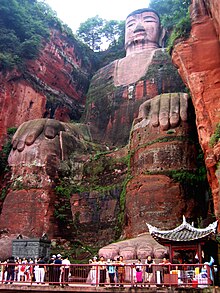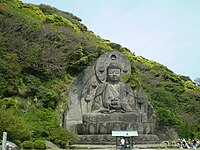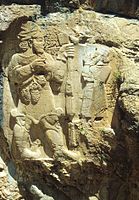Rock relief


A rock relief or rock-cut relief is a relief sculpture carved on solid or "living rock" such as a cliff, rather than a detached piece of stone. They are a category of rock art, and sometimes found as part of, or in conjunction with, rock-cut architecture.[1] However, they tend to be omitted in most works on rock art, which concentrate on engravings and paintings by prehistoric peoples. A few such works exploit the natural contours of the rock and use them to define an image, but they do not amount to man-made reliefs. Rock reliefs have been made in many cultures throughout human history, and were especially important in the art of the ancient Near East.[2] Rock reliefs are generally fairly large, as they need to be in order to have an impact in the open air. Most of those discussed here have figures that are over life-size, and in many the figures are multiples of life-size.
Stylistically they normally relate to other types of sculpture from the culture and period concerned, and except for
The first requirement for a rock relief is a suitable face of stone; a near-vertical cliff minimizes the work required, otherwise a sloping rock face is often cut back to give a vertical area to carve. Most of the ancient Near East was well supplied with hills and mountains offering many cliff faces. An exception was the land of Sumer, where all stone had to be imported over considerable distances, and so the art of Mesopotamia only features rock relief around the edges of the region. The Hittites and ancient Persians were the most prolific makers of rock reliefs in the Near East.[4]
The form is adopted by some cultures and ignored by others. In the many
Egypt
Although prehistoric engraved
Before they were cut away and moved, the colossal figures outside the
Hittites and Assyrians
The Hittites were important producers of rock reliefs, which form a relatively large part of the few artistic remains they have left.[8] The Karabel relief of a king was seen by Herodotus, who mistakenly thought it showed the Egyptian Pharaoh Sesostris.[9] This, like many Hittite reliefs, is near a road, but actually rather hard to see from the road. There are more than a dozen sites, most over 1000 metres in elevation, overlooking plains, and typically near water. These perhaps were placed with an eye to the Hittite's relation to the landscape rather than merely as rulers' propaganda, signs of "landscape control", or border markers, as has often been thought.[10] They are often at sites with a sacred significance both before and after the Hittite period, and apparently places where the divine world was considered as sometimes breaking through to the human one.[11]

At Yazılıkaya, just outside the capital of Hattusa, a series of reliefs of Hittite gods in procession decorate open-air "chambers" made by adding barriers among the natural rock formations. The site was apparently a sanctuary, and possibly a burial site, for the commemoration of the ruling dynasty's ancestors. It was perhaps a private space for the dynasty and a small group of the elite, unlike the more public wayside reliefs. The usual form of these is to show royal males carrying weapons, usually holding a spear, carrying a bow over their shoulder, with a sword at their belt. They have attributes associated with divinity, and so are shown as "god-warriors".[12]
The Assyrians probably took the form from the Hittites; the sites chosen for their 49 recorded reliefs often also make little sense if "signalling" to the general population was the intent, being high and remote, but often near water. The Neo-Assyrians recorded in other places, including metal reliefs on the
Persia
The large carved rock relief, typically placed high beside a road, and near a source of water, is a common medium in Persian art, mostly used to glorify the king and proclaim Persian control over territory.
Behistun is unusual in having a large and important inscription, which like the Egyptian
Only one has inscriptions and the matching of the other kings to tombs is somewhat speculative; the relief figures are not intended as individualized portraits. The third from the left, identified by an inscription, is the tomb of
Well below the Achaemenid tombs, near ground level, are rock reliefs with large figures of
The seven Sassanian reliefs, whose approximate dates range from 225 to 310 AD, show subjects including investiture scenes and battles. The earliest relief at the site is
Sassanian reliefs are concentrated in the first 80 years of the dynasty, though one important set are 6th-century, and at relatively few sites, mostly in the Sassanid heartland. The later ones in particular suggest that they draw on a now-lost tradition of similar reliefs in palaces in stucco. The rock reliefs were probably coated in plaster and painted.[28]
The rock reliefs of the preceding Persian Seleucids and
The standard catalogue of pre-Islamic Persian reliefs lists the known examples (as at 1984) as follows: Lullubi #1–4; Elam #5–19; Assyrian #20–21; Achaemenid #22–30; Late/Post-Achaemenid and Seleucid #31–35; Parthian #36–49; Sasanian #50–84; others #85–88.[32]
India

Although carving into solid rock is more a feature of Indian sculpture than of any other culture, most Indian sculptures fall outside the strict definition of rock reliefs because they are either fully detached statues, or are reliefs within rock-cut or natural caves, or temples entirely cut from the living rock. In the former group are many colossal
However, there are a number of significant rock reliefs in India, with the
-
Mahabalipuram, 7th century
-
The sleepingAnantashayi Vishnu, 9th century
-
Tirumalai, Tamil Nadu, c. 12th century
Buddhism

Buddhism, originating in India, took the traditions of cave and rock-cut architecture to other parts of Asia, including the creation of rock reliefs.[39] In these the emphasis shifted to religious subject matter; in earlier reliefs deities had normally appeared only to show their approval of the ruler. The colossal Buddha figures are nearly all in very high relief, only still attached to the rock face at the rear. Several have or had "image houses", or buildings enclosing them, which meant that they could normally only be seen very close up, and the impressive view from further back was lost to pilgrims.
In Sri Lanka colossal Buddha figures include the Avukana Buddha statue, 5th century and almost free-standing, with only a narrow strip at the back still connecting it to the cliff, and the four 12-century Buddha figures at Gal Vihara; the brick foundations for image houses can be seen here. The seven 10th-century figures at Buduruvagala are in much lower relief. There are very lively elephants carved around a temple pool at Isurumuniya.[40] Of the colossal lion gateway to the hill-palace at Sigiriya, only the paws remain, the head having fallen off at some point.
The three famous ancient Buddhist sculptural sites in China are the Mogao Caves,[41] Longmen Grottoes (672–673 for the main group) and Yungang Grottoes (460–535), all of which have colossal Buddha statues in very high relief, cut back into huge niches in the cliff,[42] though the largest figure at Mogao is still enclosed by a wooden image house superstructure in front of it; this is also thought to be a portrait of the reigning empress Wu Zetian. One of the Longmen figures is effectively in a man-made cave, but can be seen from outside through a large window opened in the outer face (see gallery). Smaller rock-cut sculptures and paintings decorate the cave temples at these sites.
The
The
Sites elsewhere include Kbal Spean near Angkor in Cambodia, which has both Hindu and Buddhist reliefs. These are placed in rocky shallows of the river, with water flowing over them. Large numbers of short lingams and deities were intended to purify the water that flowed over them on its way to the city.[47]
-
Avukana Buddha statue, Sri Lanka, 5th century
-
The larger of the Buddhas of Bamiyan in 1963, before it was destroyed
-
Part of theLongmen Grottos
-
No 5 at the Yungang Grottoes
-
Detail of the colossal group at the Maijishan Grottoes
-
Details of part of theDazu rock carvings
Greek and Roman world

The Greco-Roman
Medieval Europe
Standing alone in early medieval Europe is the Madara Rider in Bulgaria, cut around 700 above the palace of a ruler of the Bulgars. It shows a rider, about double life-size, spearing a lion, with a dog running behind him.[51] Though the medium of rock relief is without parallels anywhere near, this motif, known as the Thracian horseman, had long been common on stelae in the region, and such motifs appear in metalwork,[52] such as the ewer with a mounted warrior and his prisoner in the enigmatic Treasure of Nagyszentmiklós, and are common in Sasanian silver bowls, which may well have been traded as far as the Balkans.
The (probably) 12th-century Externsteine relief in southern Germany measures 4.8 m high by 3.7 m wide. It shows the Descent from the Cross of Jesus, a standard scene from Christian art, with a total of ten figures.[53]: 4 The circumstances of its making remain unclear, and despite the extensive tradition of medieval reliefs on buildings, making them on natural rock formations at a large size remained very rare.
Americas

Pre-Columbian rock reliefs, mostly using a low relief, include those at
The
Modern
Modern rock reliefs tend to be colossal, at several times life-size, and are usually memorials of some sort. In America, Mount Rushmore is mostly in a very high relief, and the Stone Mountain relief commemorating three Confederate generals in bas-relief. The rock sculpture of Decebalus in Romania is a huge face on an outcrop above the Danube, begun in 1994.[56] The Lion Monument or Lion of Lucerne, in Lucerne, Switzerland, is one of the most artistically successful, designed by Bertel Thorvaldsen and carved in 1820–21 by Lukas Ahorn, as a memorial for the Swiss Guards who were massacred in 1792 during the French Revolution.[57]
-
The Hittite İvriz relief; King Warpalawas (right) before the god Tarhunzas
-
Sassanian investiture relief of Shapur I at Naqsh-e Rajab
-
12th-century Externsteine relief, Germany, with the Descent from the Cross of Jesus
-
The Lion Monument of Lucerne
See also
- List of colossal sculpture in situ
Notes
- ^ Harmanşah (2014), 5–6
- ^ Harmanşah (2014), 5–6; Canepa, 53
- ^ for example by Rawson and Sickman & Soper
- ^ Canepa, 53
- ^ Harmanşah (2014a), 95–96; Kreppner, 372–373; St. Chad Boscawen, Sir William, full map "The Monuments and Inscriptions on the Rocks at Nahr", Transactions of the Society of Biblical Archæology, vol 7, 1882, Longmans, Green, Reader and Dyer, pages 331–352
- ISBN 0191590592, 9780191590597
- ^ Harmanşah (2014a), 95
- ^ Bonatz
- ^ Harmanşah (2014a), 88–89; Livius.org on "The relief of Sesostris" in Herodotos' Histories 2.102–103, 106
- ^ Harmanşah (2014a), 90–94; Ullmann, Lee Z., in Harmanşah (2014), Chapter 8; though see also Bonatz
- ^ Harmanşah (2014a), 92
- ^ Bonatz
- ^ Kreppner, throughout; 368 for 49 reliefs
- ^ Kreppner, 371; Malko, Helen, "Neo-Assyrian Rock Reliefs: Ideology and Landscapes of an Empire", Metropolitan Museum, accessed 28 November 2015
- ^ Kreppner, 374–375
- ^ Kreppner, 369–370; Van der Spek, R.J., "The Assyrian Royal Rock Inscription from Shikaft-i Gulgul", Iranica Antiqua, vol XII, 1977
- ^ Canepa, 53 and throughout. Canepa, 63–64, 76–78 on siting
- ^ Luschey; Canepa, 55–57
- ^ Herrmann and Curtis
- ^ Luschey
- ^ Herrmann and Curtis
- ^ Cotterell, 162; Canepa, 57–59, 65–68
- ^ Cotterell, 162; Canepa, 57–59, 65–68
- ^ Herrmann and Curtis; Canepa, 62, 65–68
- ^ Vanden Berghe #27–29
- ^ Herrmann and Curtis; Canepa, 74–76
- ^ Herrmann and Curtis
- ^ Herrmann and Curtis
- ^ Canepa, 59–61, 68–73
- ^ Downey; Canepa, 59–60
- ^ Herrmann and Curtis
- ^ Vanden Berghe, Louis, Reliefs rupestres de l' Iran ancien, 1983, Brussels, per online summary of his list here
- ^ Harle, chapters 9 and 10
- ^ Spink, 5–6
- ^ Harle, 278-83
- ^ "Anantasayana Visnu, Saranga, Dist. – Dhenkanal" (PDF). Indira Gandhi National Centre for the Arts for Archaeological Survey of India. Retrieved 4 December 2012.
- ^ Sah, Ayodhya Prasad (1972). Life in mediaeval Orissa, cir. A.D. 600-1200. Chaukhambha Orientalia. p. 101. Retrieved 4 December 2012.
- ^ Senapati, Nilaman; Sahu, N. K. (1972). Orissa District Gazetteers: Sambalpur. Gyan Books. pp. 47, 133, 440. Retrieved 4 December 2012.
- ^ Sickman & Soper, 85–90
- ^ Harle, 450–456
- ^ Rawson, 319. The rock at Dunhuang is a weak "gravel conglomerate", and the sculptures are finished in clay, with smaller ones being entirely clay.
- ^ Rawson, 320–322
- ^ Rawson, 151–154; Sickman & Soper, 87–95, 144–147
- ^ Rawson, 322; UNESCO, World Heritage List "Dazu Rock Carvings", accessed 27 November 2015
- ^ Rawson, 319
- ^ Sickman & Soper, 87; this conventional view may not be correct, see Rawson, 318
- ^ Jessup, 122–123
- ISBN 978-0-86054-652-8, S. 50–51, 128–137.
- ^ Downey
- ISBN 0714114316
- ^ UNESCO, World Heritage Sites List, "Madara Rider"
- ISBN 1611328683, 9781611328684
- ISBN 978-3-941726-18-5.
- ^ "Monument 1: Relief of "El Rey" (The King)", and Chalcatzingo index page; "Art 447H. Mesoamerican. Olmec", Cal State
- ^ Gartner, William Gustav, "Mapmaking in the Central Andes" PDF, pp. 285–289
- ^ Foundation website
- ^ Lion Monument, Lucerne, All About Switzerland travelguide. Accessed 13 November 2015
References
- Bonatz, Dominik, "Religious Representation of Political Power in the Hittite Empire", in Representations of Political Power: Case Histories from Times of Change and Dissolving Order in the Ancient Near East, eds, Marlies Heinz, Marian H. Feldman, 2007, Eisenbrauns, ISBN 157506135X, 9781575061351, google books
- Canepa, Matthew P., "Topographies of Power, Theorizing the Visual, Spatial and Ritual Contexts of Rock Reliefs in Ancient Iran", in Harmanşah (2014), google books
- Cotterell, Arthur (ed), The Penguin Encyclopedia of Classical Civilizations, 1993, Penguin, ISBN 0670826995
- Downey, S.B., "Art in Iran, iv., Parthian Art", Encyclopaedia Iranica, 1986, Online text
- Harle, J.C., The Art and Architecture of the Indian Subcontinent, 2nd edn. 1994, Yale University Press Pelican History of Art, ISBN 0300062176
- Harmanşah, Ömür (2014a), "Rock Reliefs are Never Finished", in Place, Memory, and Healing: An Archaeology of Anatolian Rock Monuments, 2014, Routledge, ISBN 1317575725, 9781317575726, google books
- Harmanşah, Ömür (ed) (2014), Of Rocks and Water: An Archaeology of Place, 2014, Oxbow Books, ISBN 1782976744, 9781782976745
- Herrmann, G, and Curtis, V.S., "Sasanian Rock Reliefs", Encyclopaedia Iranica, 2002, Online text
- Jessup, Helen Ibbetson, Art and Architecture of Cambodia, 2004, Thames & Hudson (World of Art), ISBN 050020375X
- Kreppner, Florian Janoscha, "Public Space in Nature: The Case of Neo-Assyrian Rock-Reliefs", Altorientalische Forschungen, 29/2 (2002): 367–383, online at Academia.edu
- Ledering, Joan, "Sasanian Rock Reliefs", http://www.livius.org
- Luschey, Heinz, "Bisotun ii. Archeology", Encyclopaedia Iranica, 2013, Online text
- ISBN 9780714124469
- Sickman, Laurence, in: Sickman L. & Soper A., The Art and Architecture of China, Pelican History of Art, 3rd ed 1971, Penguin (now Yale History of Art), LOC 70-125675
- Spink, Walter M., Ajanta: History and Development Volume 5: Cave by Cave, 2006, Brill, Leiden, ISBN 90-04-15644-5, online

















